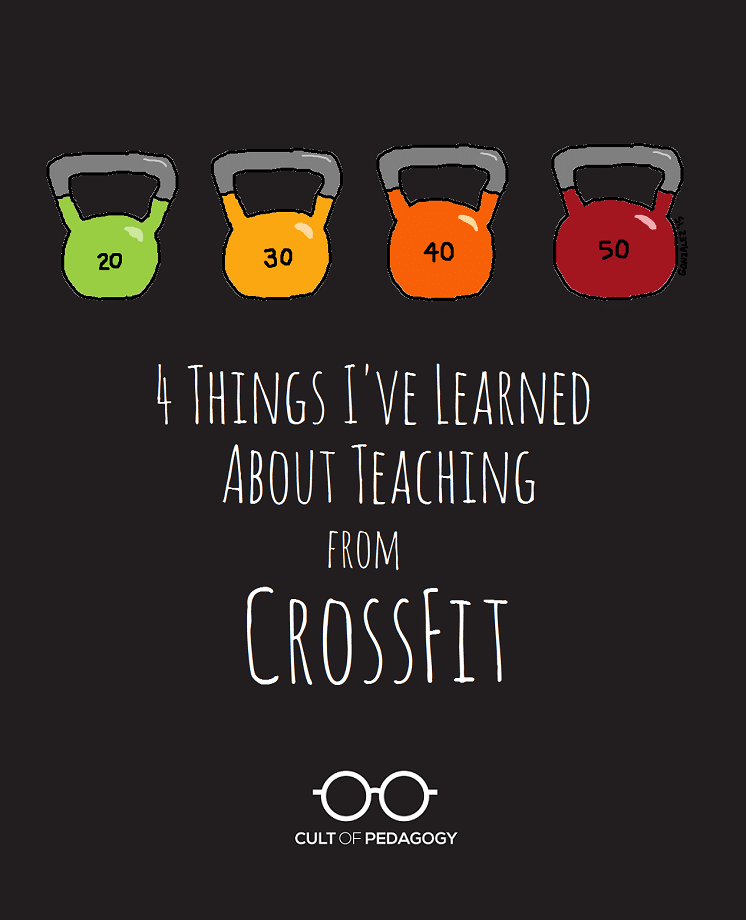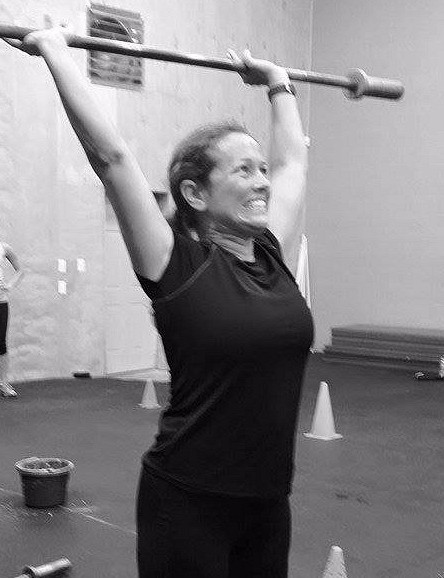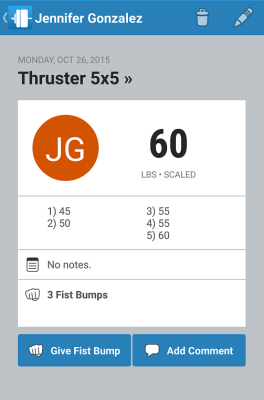4 Things I’ve Learned About Teaching from CrossFit

Listen to this post as a podcast:
This past summer, my husband asked me to go to a CrossFit gym with him. He was looking for something different, something that would motivate him to exercise more. He’d heard about CrossFit and thought it sounded promising, so he asked me to go with him to a “newbie night” to try a sample workout. Knowing full well that this would be a one-time favor, I went along.
When we approached the gym (or box, as they call it in CrossFit), my skepticism only grew stronger. The building looked like a garage and the black rubber floor filled the room with the smell of tires. There appeared to be a few pieces of workout equipment around, hanging on the walls mostly, and a few people were lifting these huge barbells, but mostly everyone was just hanging out, talking. And drinking coffee, for some odd reason. My plan was to politely tolerate whatever the next hour brought, but I was positive this would never be a place I’d call home.
Fast-forward three months, and I am completely in love with this place. I have cancelled my other gym membership, I’m thrilled by how strong I feel, and I’m more motivated to exercise than I have ever been.
This is ironic, because I kind of suck at it. If you compare what I can do to what the more experienced people can do, there’s no contest. I am absolutely in the lower tier of students: I use lighter weights, I do fewer reps, I need more breaks, and I take longer to do just about everything. For the first time, I understand what it feels like to be a struggling student. I understand what it’s like to feel totally lost, confused, and unskilled, surrounded by others who seem to know exactly what they’re doing. But because of the way CrossFit is structured, I keep trying. And I have no plans to stop.
Why is that? Why am I, a struggling student, still motivated? I’ve done some thinking about it, and I believe it comes down to four principles, four aspects of the CrossFit approach that are really working for me. I think we can apply these same principles to our classroom teaching and get better results, especially from students who don’t naturally perform to their potential. Here they are:
1: Student choice + well-crafted options = powerful differentiation.
Every time I show up to the gym, I look to a huge blackboard for the Workout of the Day, known by CrossFitters as the WOD. The WOD is a list of whatever exercises we’re going to do that day, how many reps, for how long, and so on. But on most days, the WOD is not alone: Beside it, there’s usually some extra information titled “JV.” This is a list of the modifications we can make if the prescribed WOD is too difficult. (In almost every case, it is way too hard for me). Usually, these modifications involve scaling down the weight we use or reducing the number of reps we have to do. If the JV version is too hard, they often offer a “Frosh” version that’s scaled down even further.
Suppose the WOD includes a series of overhead presses with a barbell. The prescribed weight for women might be 90 pounds. The scaled weight might be 70 pounds. But when I first tried it, all I could lift for any length of time was the 25 lb barbell, alone, with no weights added.

Me, struggling to hold a 25-lb bar over my head. I’m a beast, I know.
Here’s the most important thing about these modifications: We are never assigned to use them. Modifying our workout is our decision, every time. So on some days, I’ll look at the WOD and know for sure that I’ll need to make a lot of modifications. On other days I look at the WOD and think, I’m going for it. Sometimes I get partway through and think NEVER MIND. But other times I nearly get there. Those days are golden.
Also: No one ever, EVER makes you feel crappy about scaling down. People were cheering me on with those little barbell presses. It didn’t feel condescending, either. Just supportive. I knew they had all been beginners once, too.
Classroom application: Whenever possible, we should tier our assignments, but let students choose which tier to work on. Students should be able to change course if the tier they’ve chosen turns out to be too hard or too easy: Spend time helping them understand how both of those situations feel. Make sure that in your classroom, scaling down is looked upon as a smart, self-aware move, not a sad option for the weak or the slow. And keep raising the bar: As soon as they show signs of readiness, encourage students to attempt the next level.
2: Variety matters.
One foundation of CrossFit is that the workouts are constantly varied, sometimes not repeating themselves for months at a time. This allows participants to learn and develop a wide range of skills and prevents us from hitting plateaus. I like it because I’m never bored. In every other fitness regimen I’ve tried, I could eventually predict the routine—even Zumba got boring—and dragging myself to the gym became a chore. With CrossFit, I never know exactly what we’re going to do, and because certain exercises aren’t repeated for long periods of time, I’m excited when they come up.
Classroom application: Find new ways to add variety to your class routine. This sounds obvious, but so many of us get into a rut without realizing it. Yes, students thrive on predictability, but if you can chunk your content and skills into shorter, more intense activities, then mix them up, the energy level in your class will go up and you’ll keep students wanting to come back. For an English language arts class, this might mean one day includes a grammar review game, then a quick write, followed by two student read-alouds of pieces they are working on. The next day could start with a 15-minute session of Philosophical Chairs to practice speaking skills, followed by 15 minutes of self-selected silent reading, and finishing up with a fast proofreading exercise. In a math class, students could start with a Reciprocal Learning activity to review learning from the day before, followed by a Number Talk, and finally a team competition with Kahoot. The next day could include some work with manipulatives, then a Gallery Walk where groups solve problems together, finishing with a few minutes singing a song that helps students remember an important math concept.
3: Gamification works.
Our gym encourages us to use an app called SugarWOD to record our stats for each workout. Earlier this week, for example, we had to do 5 rounds of “Thrusters,” where we lift weight up over our heads, and in each round are supposed to increase the weight a little bit. Once I was done, I went into SugarWOD and entered my information:

Just the act of entering my numbers is satisfying. It’s motivating. It makes me want to finish the workout just so I can put my numbers into the app. Then I can check out the leaderboard to see what other people have done. I can give them virtual “Fist Bumps” and they can give some to me as well.
As a rookie, I don’t know much about what lies beyond this, but when I look around my gym, I see a lot of numbers and charts all over the place; people keeping track of all kinds of stats. A quick search on Google shows me that CrossFit coaches and gyms everywhere are developing systems of levels for athletes to work toward. And for me, this is motivating. Just doing “whatever I can” probably won’t sustain me, but knowing that reaching a certain max weight in a certain exercise means I’ve reached a new level of fitness? That will push me to get there faster.
Classroom application: Whenever possible, find ways to let students track their progress. In education we have trended lately toward focusing too much on data, but I’m not talking about anything that gets reported to the state or turns into a grade. I’m talking about recording your own growth over time, for your own personal satisfaction. To add more motivation, look for ways to add game mechanics—like leveling up and badges—to your classroom. In cases where a skill isn’t easily quantifiable, consider a more descriptive way to measure growth, or have students self-assess their progress based on identifiable characteristics of their work, rather than a score.
4: Personal best is most important, but a little competition helps.
Beating my own personal record is satisfying, yes. But one of the reasons CrossFit works so well for me is the fact that they have us do our workouts in groups. In a lot of cases, we are timed. This is a huge motivator for me. If someone told me I had to run one mile by myself and record my time, I would want to beat my previous time, sure. But have me run with a group of people? Now there’s peer pressure, and that pushes me harder. Because so many people at my gym are so far ahead of me, I don’t kid myself into thinking I’m going to beat their time, but I sure as heck don’t want to be crossing the finish line way, waaaaay behind them. Ultimately, doing the work with people who are better than me makes me work harder. Here’s the thing, though: If every single other person could run laps around me, and if there was no chance I was going to come anywhere close to anyone else’s time? My motivation would probably fall apart. Knowing that I was completely out of my league would make me cut myself way more slack than I should.

CrossFit Fever Games (recolored) by CrossFit Fever licensed under CC BY 2.0
Classroom application: Build opportunities into your instruction for healthy competition. Team challenges, individual challenges, competitions for time or number of items completed can all boost student motivation. But because timed tests can cause unhealthy anxiety in some kids, and competition in general isn’t for everyone, consider making these kinds of competitions strictly voluntary.
It’s easy to draw parallels between fitness and education: Achieving either one is a complex task, especially if we’re trying to help lots of people from different backgrounds get great results. You only have to watch late-night TV or open your spam folder to find proof that plenty of us still haven’t figured out how to maintain a healthy body, and no one has fully answered the question of how to effectively educate all students. CrossFit’s explosive growth in popularity is a good enough reason to look more closely at its methods and see what we might be able to apply to the classroom. As an average-to-low-level student of fitness myself, all I can say is that it’s definitely working for me. ♦
I would love to have you come back for more. Join my mailing list and get weekly tips, tools, and inspiration—in quick, bite-sized packages—all geared toward making your teaching more effective and joyful. To welcome you, I’ll be sending a free copy of my new e-booklet, 20 Ways to Cut Your Grading Time in Half. I look forward to having you join me.